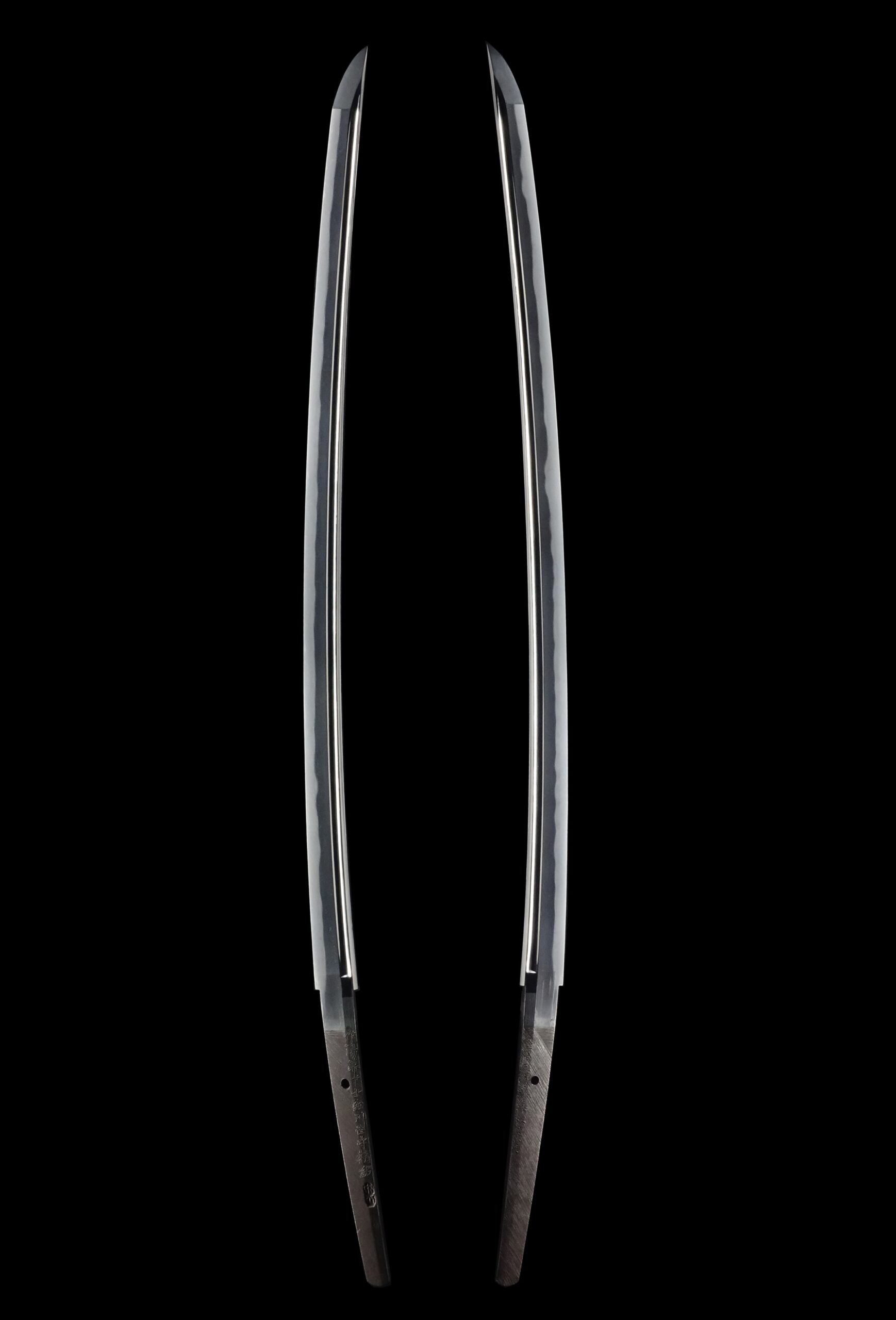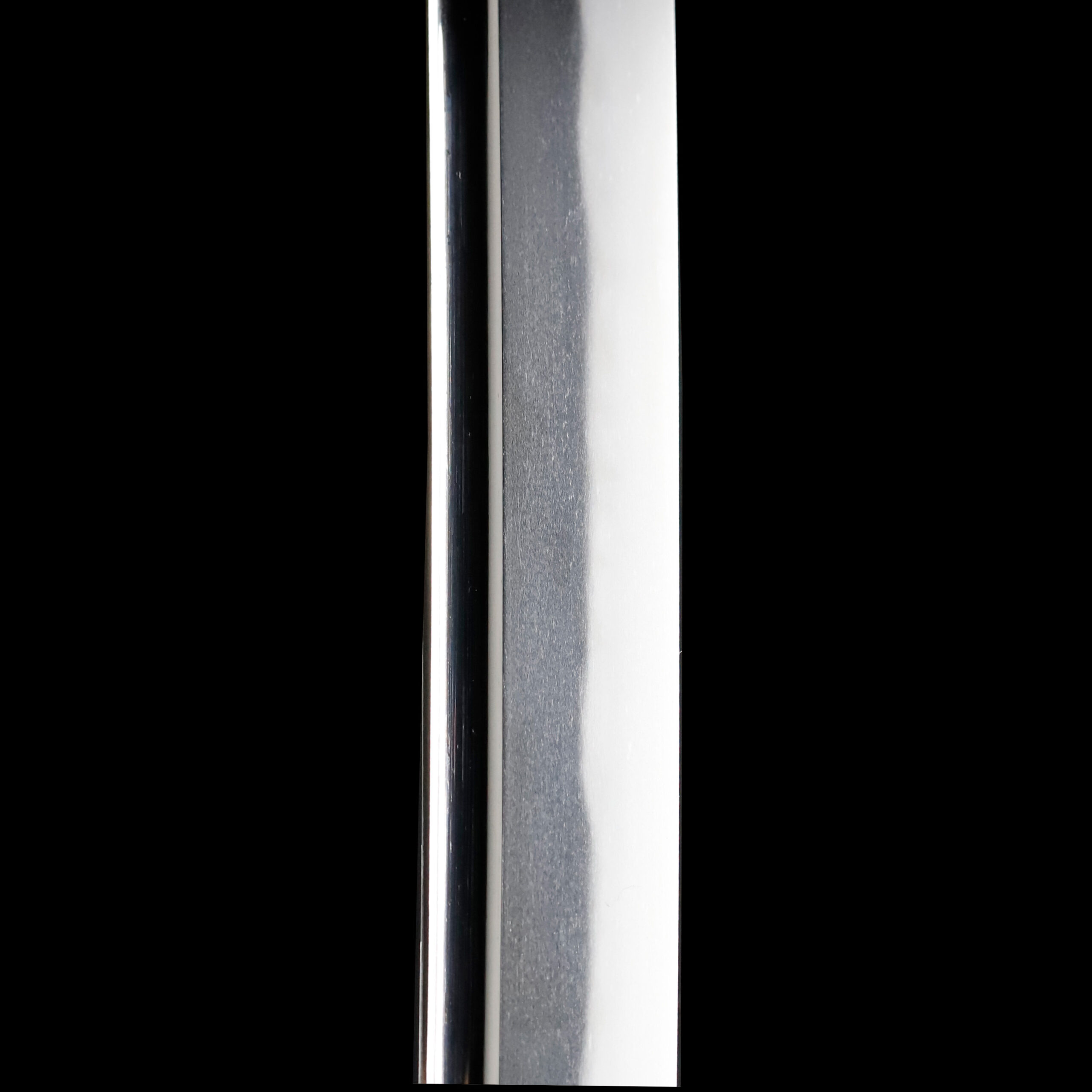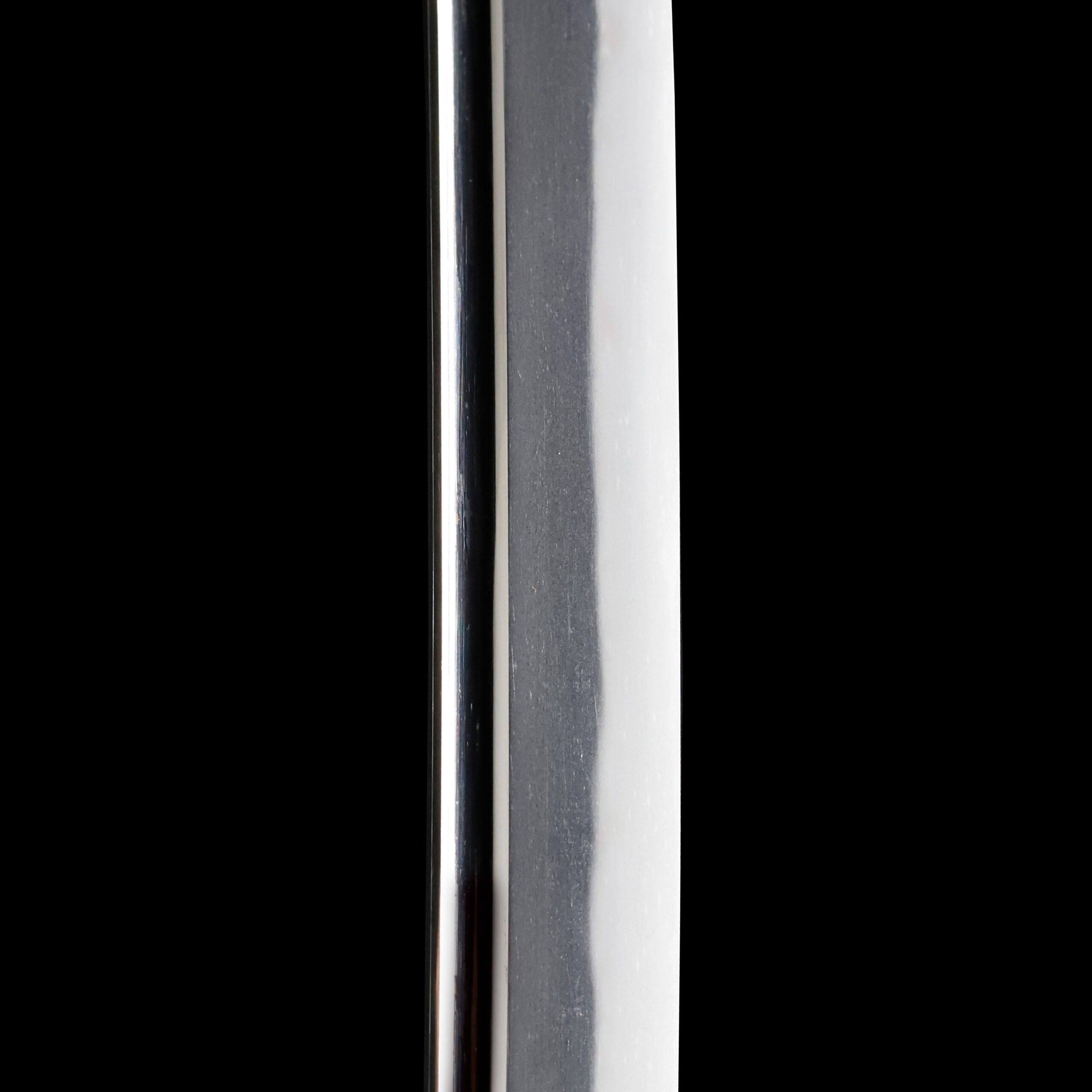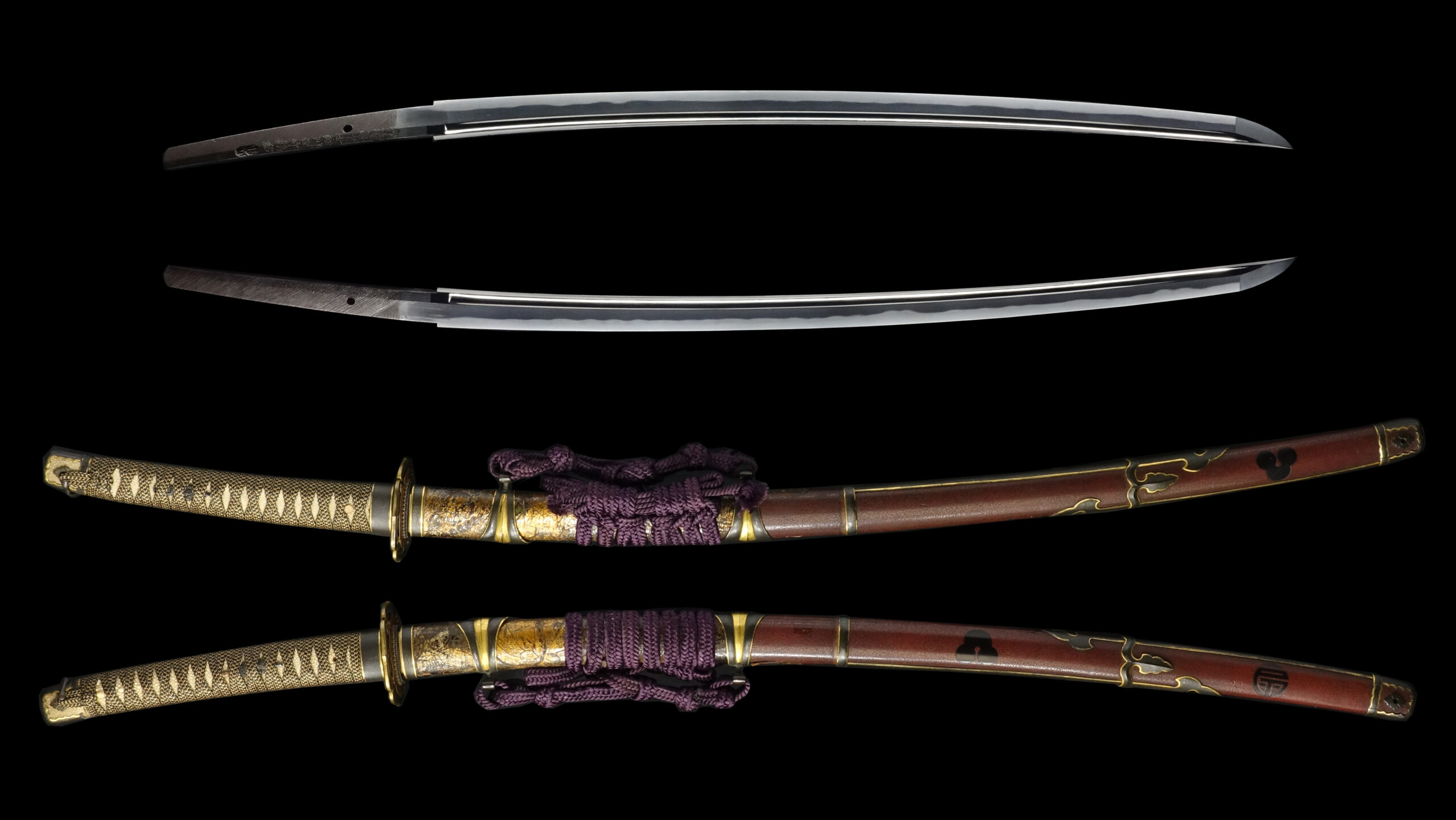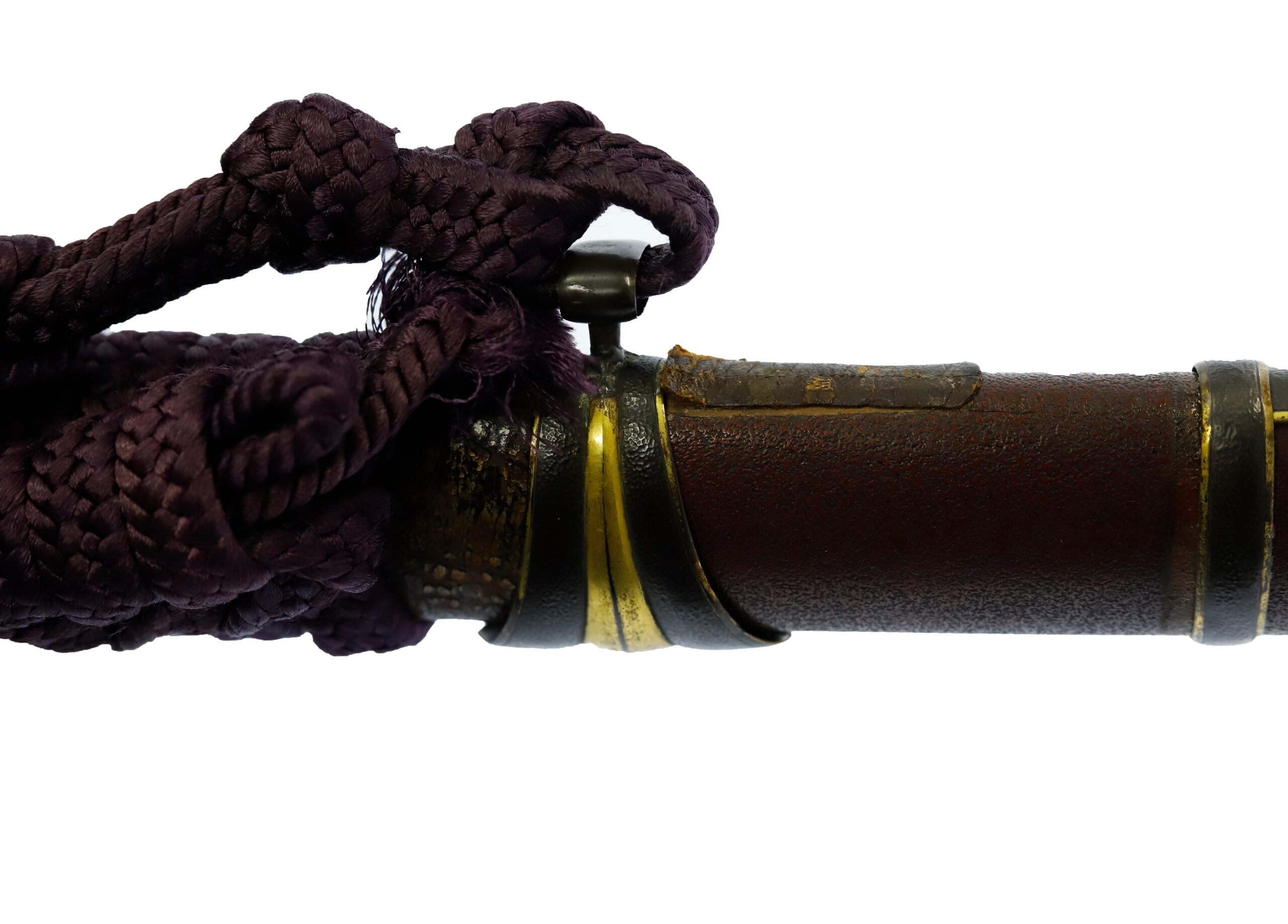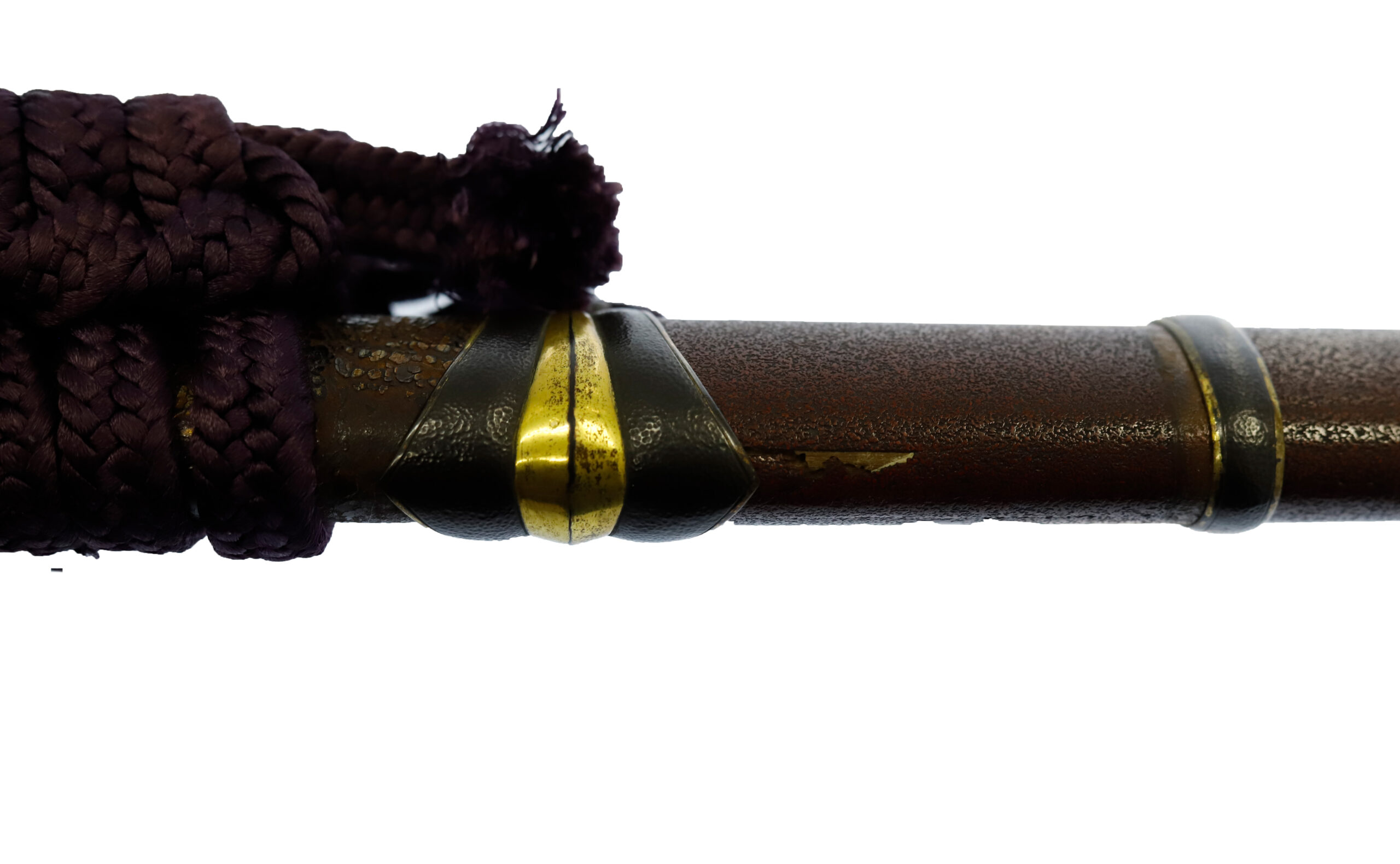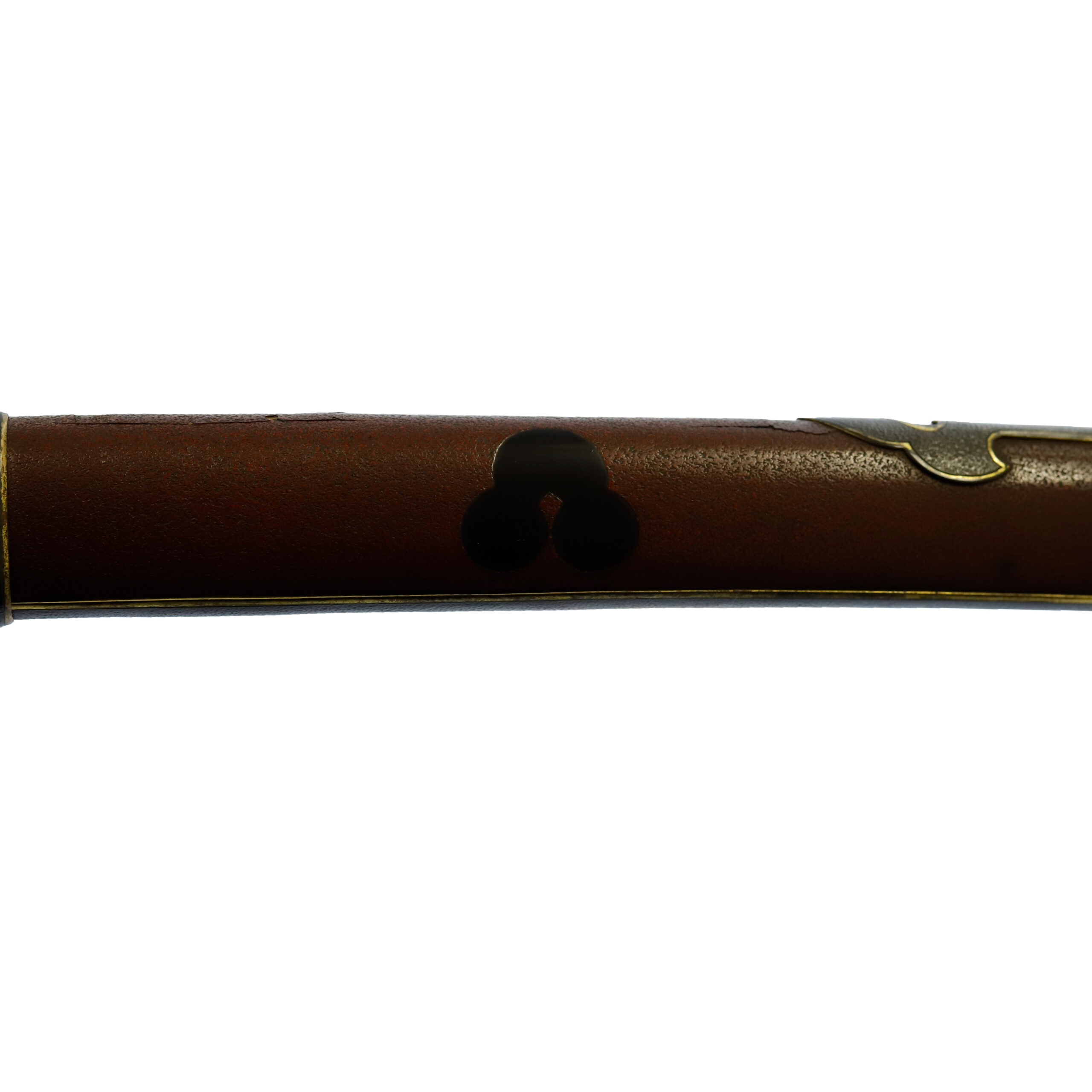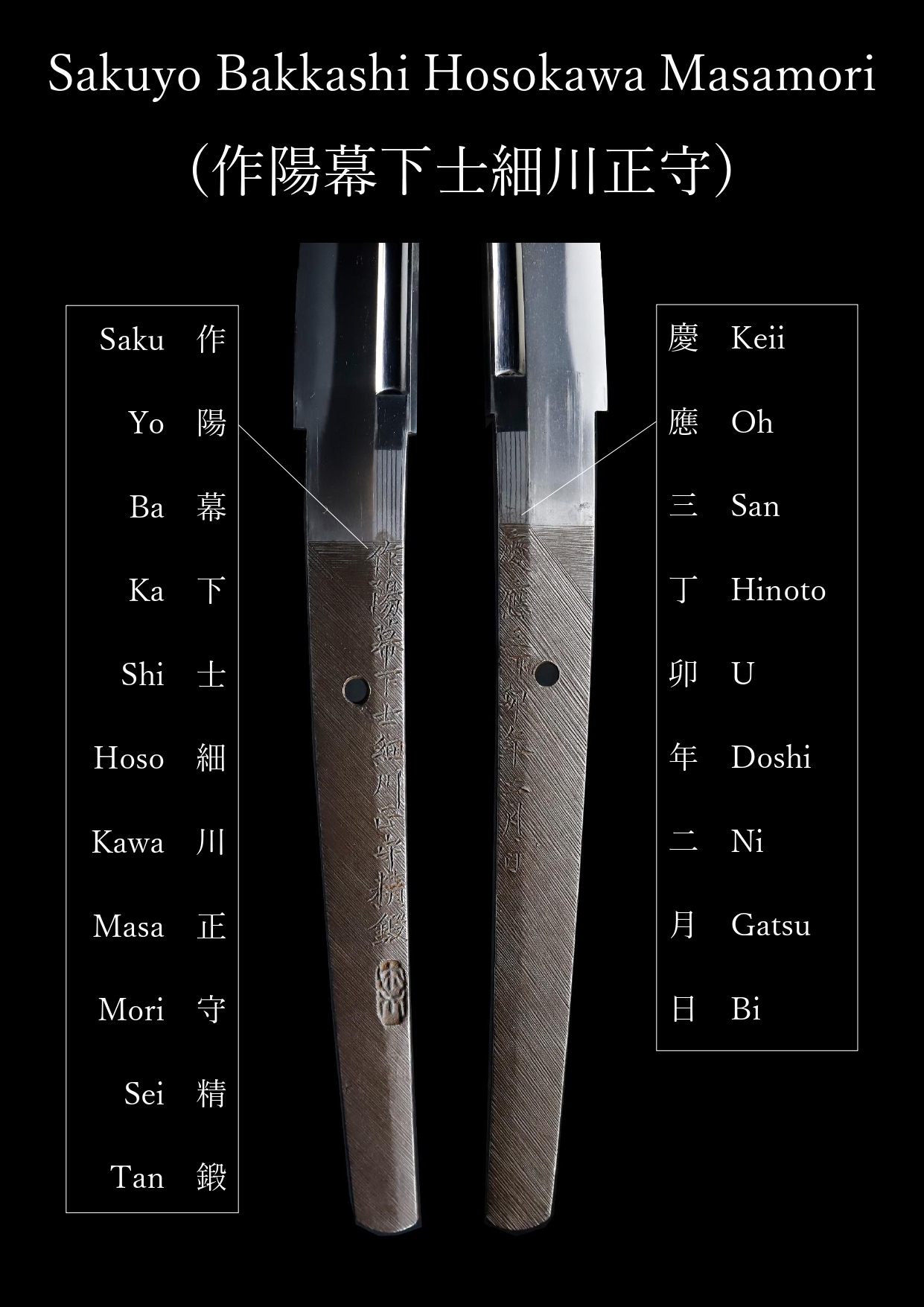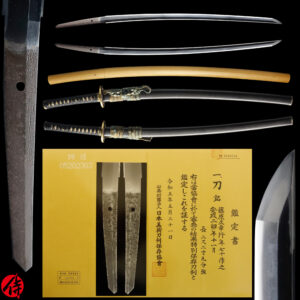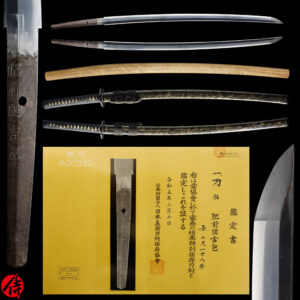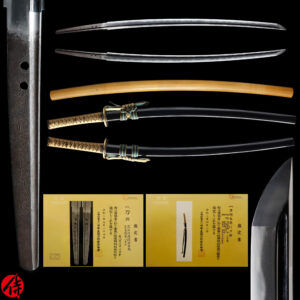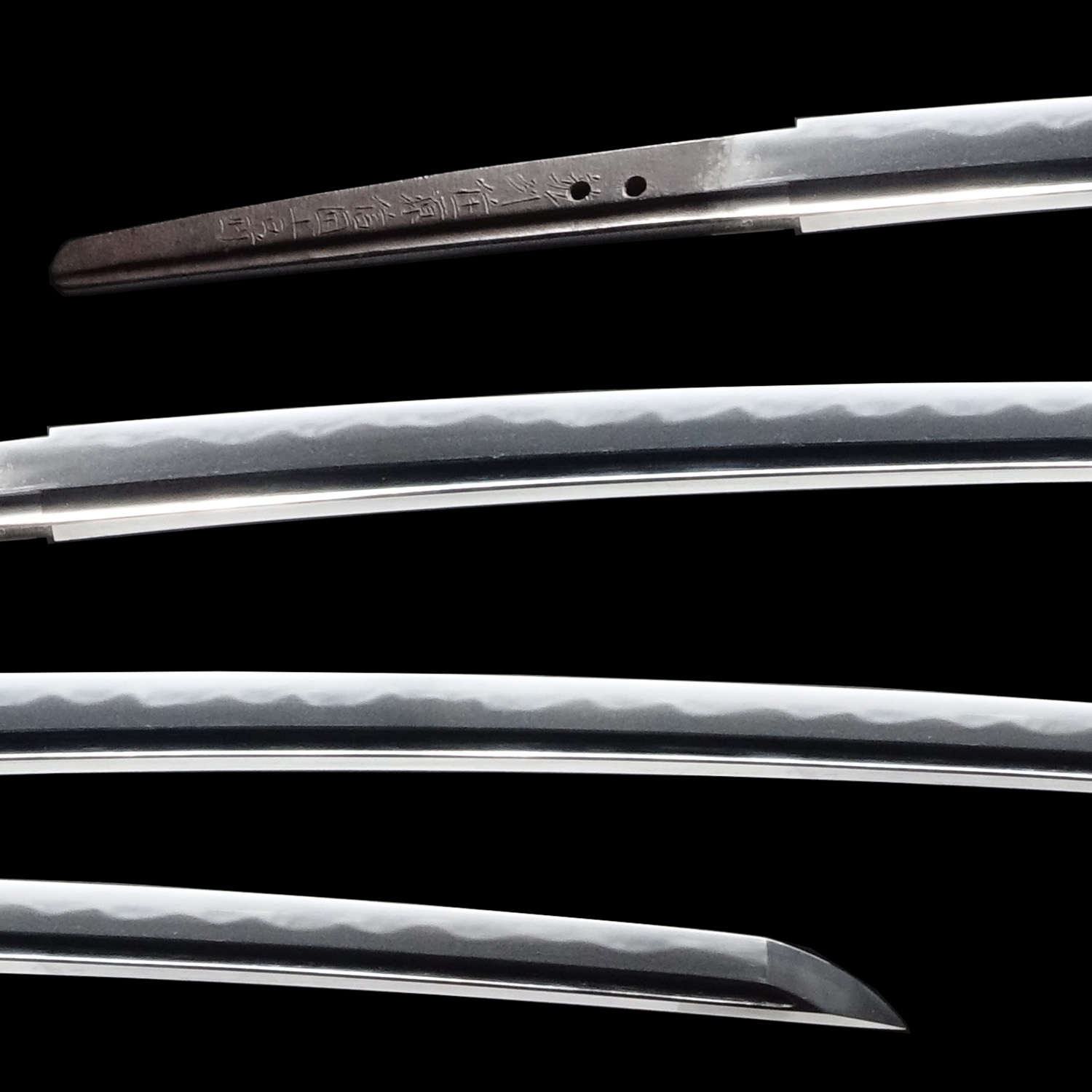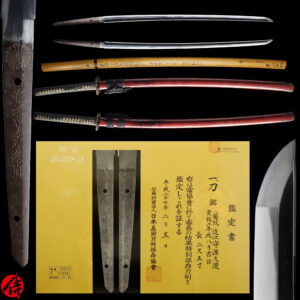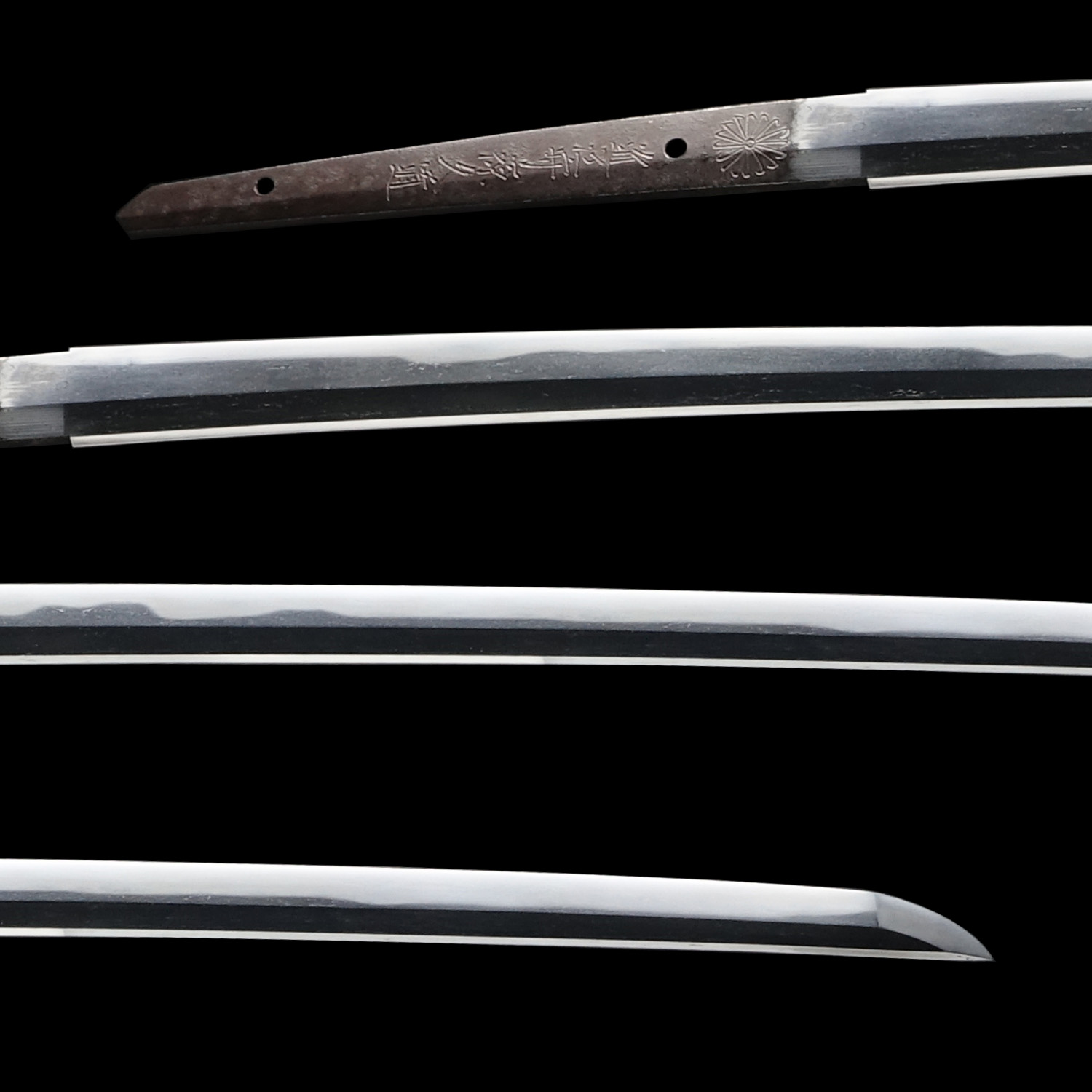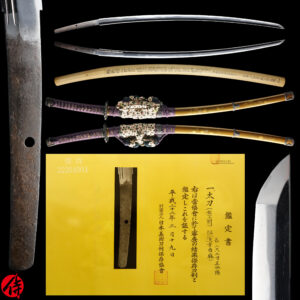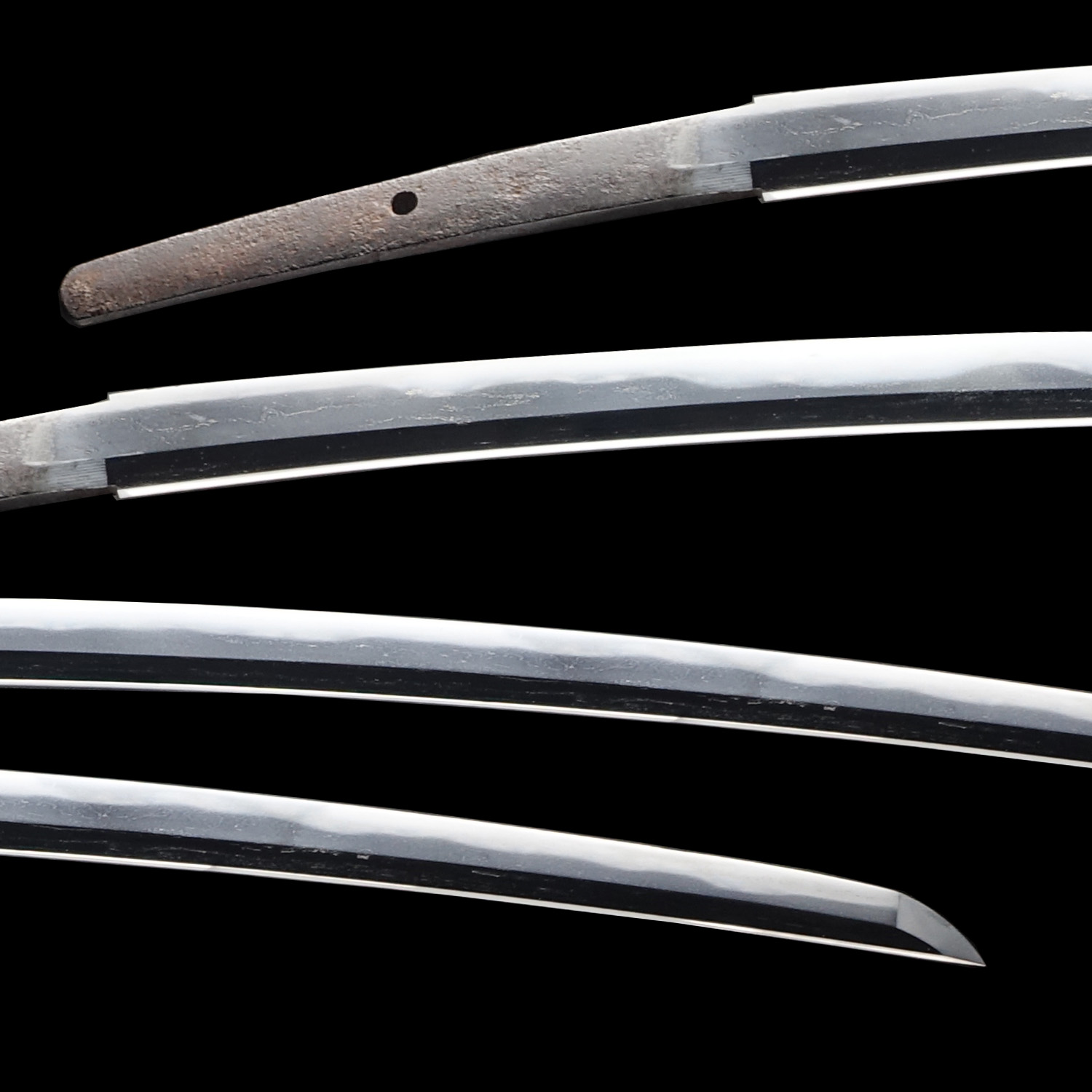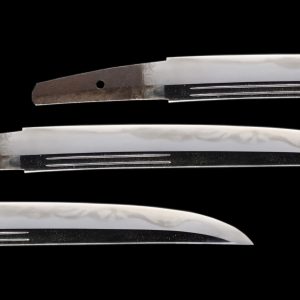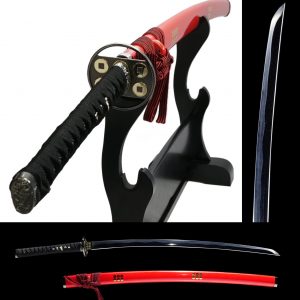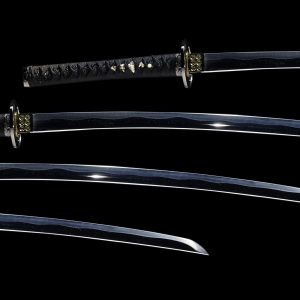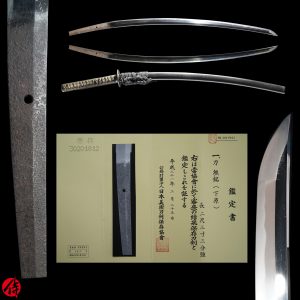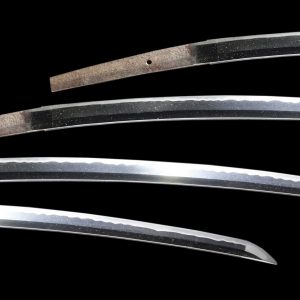Antique Japanese Sword Katana Signed by Hosokawa Masamori with Tokubetsu Hozon Certificate & Tosogu
【Description】
Summary
This blade was signed by Saku Yo Bakkashi Hosokawa Masamori (作陽幕下士細川正守) in the 3rd year of the Keio era (1867: The end of the Edo period). Saku Yo Bakkashi signifies that he was also a Samurai, and we assume he engraved these letters to show his dignity for being a Samurai. Hosokawa Masamori was active during the Koka-early Meiji era (1844-early 1870s). He was the son of Hosokawa Masayoshi, one of the most renowned swordsmiths during the late Edo period.
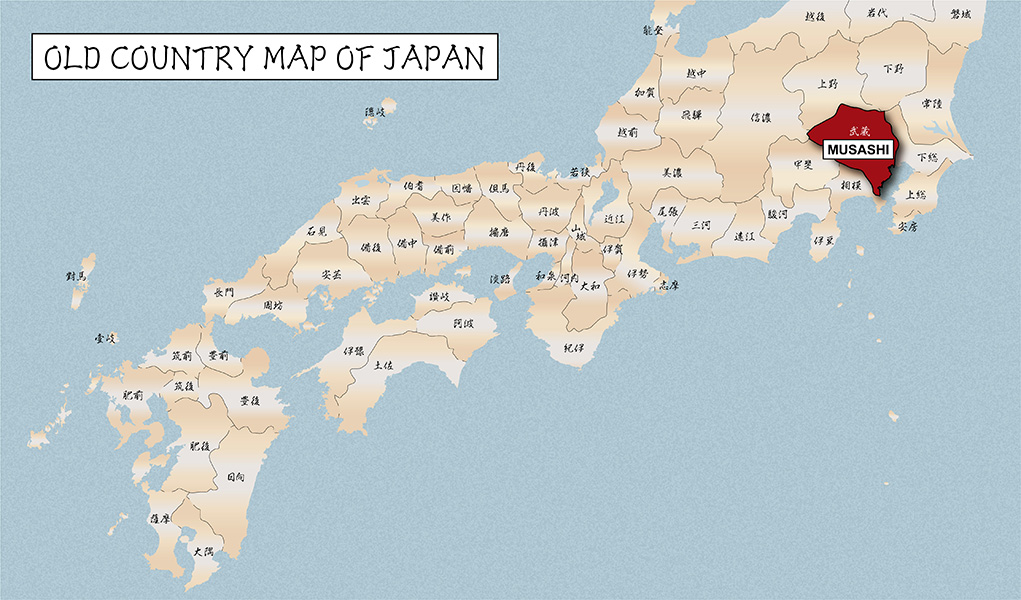
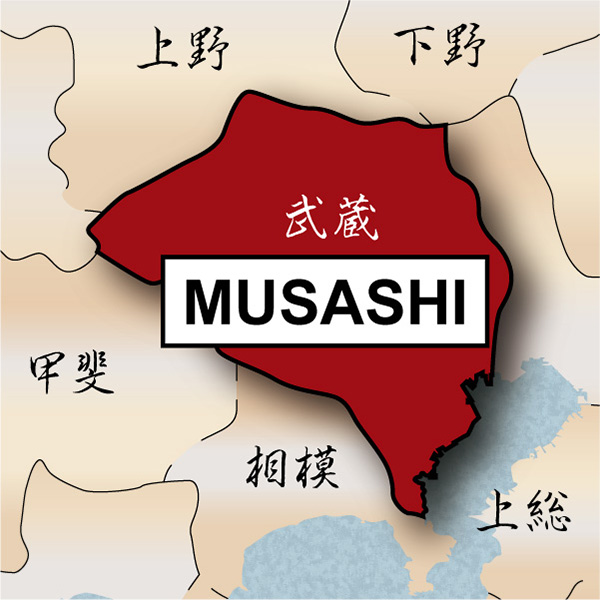
Hosokawa Masanori&Masayoshi
His father, Hosokawa Masayoshi, had learned sword-forging techniques under the master, Suishinshi Masahide(水心子正秀), one of the most famous swordsmiths in Samurai history. Masamori learned sword-forging techniques in Edo city under master Taikei Naotane, an apprentice of Suishinshi Masahide.
Masayoshi was an extremely skilled swordsmith, and he was excellent at forging blades with Choji Midare Hamon, which is the characteristic of the Bizen sword-forging style (BIZEN DEN). Masamori also mastered this excellent sword-forging technique from his father. Choji Midare Hamon is an Irregular wavy tempering line. Most of Masamori’s work reflects on Bizen Den (One of the Five Japanese sword-forging traditions). Hosokawa Masamori was famous for having a gorgeous groove (Hi: 樋) on his creations.
Mamori and his father served the Matsudaira clan in the Sakushu Tsuyama domain(today’s Okayama prefecture). They served the clan as a Hanko(藩工), who exclusively forged swords for a specific clan.
Tachi Koshirae
This blade is stored in Tachi(太刀) Koshirae. Tachi was mainly used by an armored Samurai with one hand on horseback from the Heian period (794-1185 A.D.) until the early Muromachi period. TACHI was suspended loosely on the left waist with its edge facing the ground so that you could draw it faster to cut down soldiers on the ground.
Because of its gorgeous looking, having a Tachi-style sword mounting became a social status among Samurai. This Koshirae was also appraised as a Tokubetsu Hozon Tosogu by NBTHK.
It is appraised as a Tokubetsu Hozon Token(特別保存刀剣) issued by NBTHK(Nihon Bijutsu Touken Hozon Kyokai:日本美術刀剣保存協会). This authentication paper was only given to authentic Japanese swords, especially well preserved and high quality with artistic value.
【 Blade】
Cutting Edge Length(Nagasa): 66.6 cm ( 26.2 inches)
Curvature(Sori):1.8 cm (0.70 inches)


Hamon:
The crystalline structure which forms along the cutting edge of a blade as a result of the hardening process
Jimon(Jihada):
visible steel surface pattern created by folding and hammering during forging process

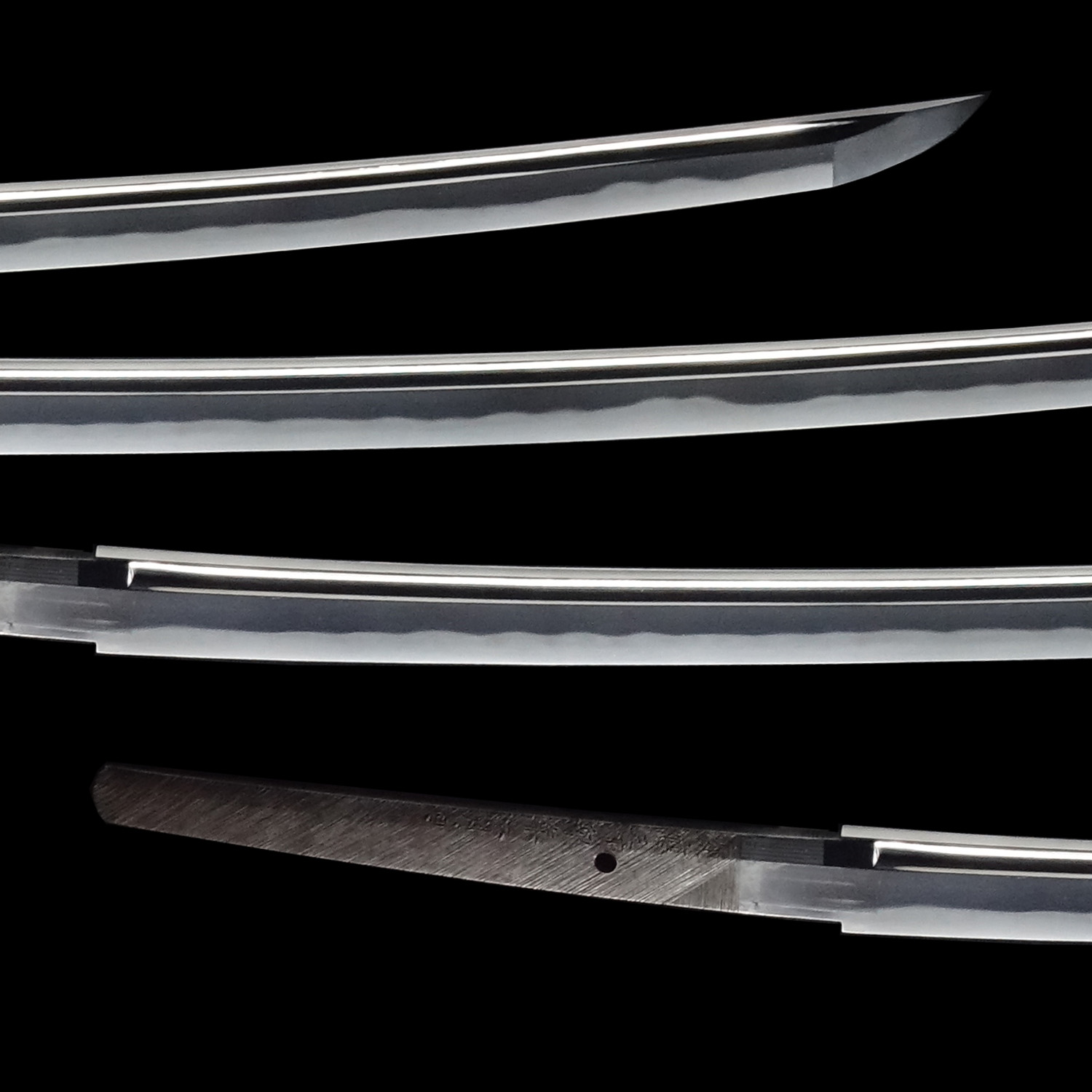

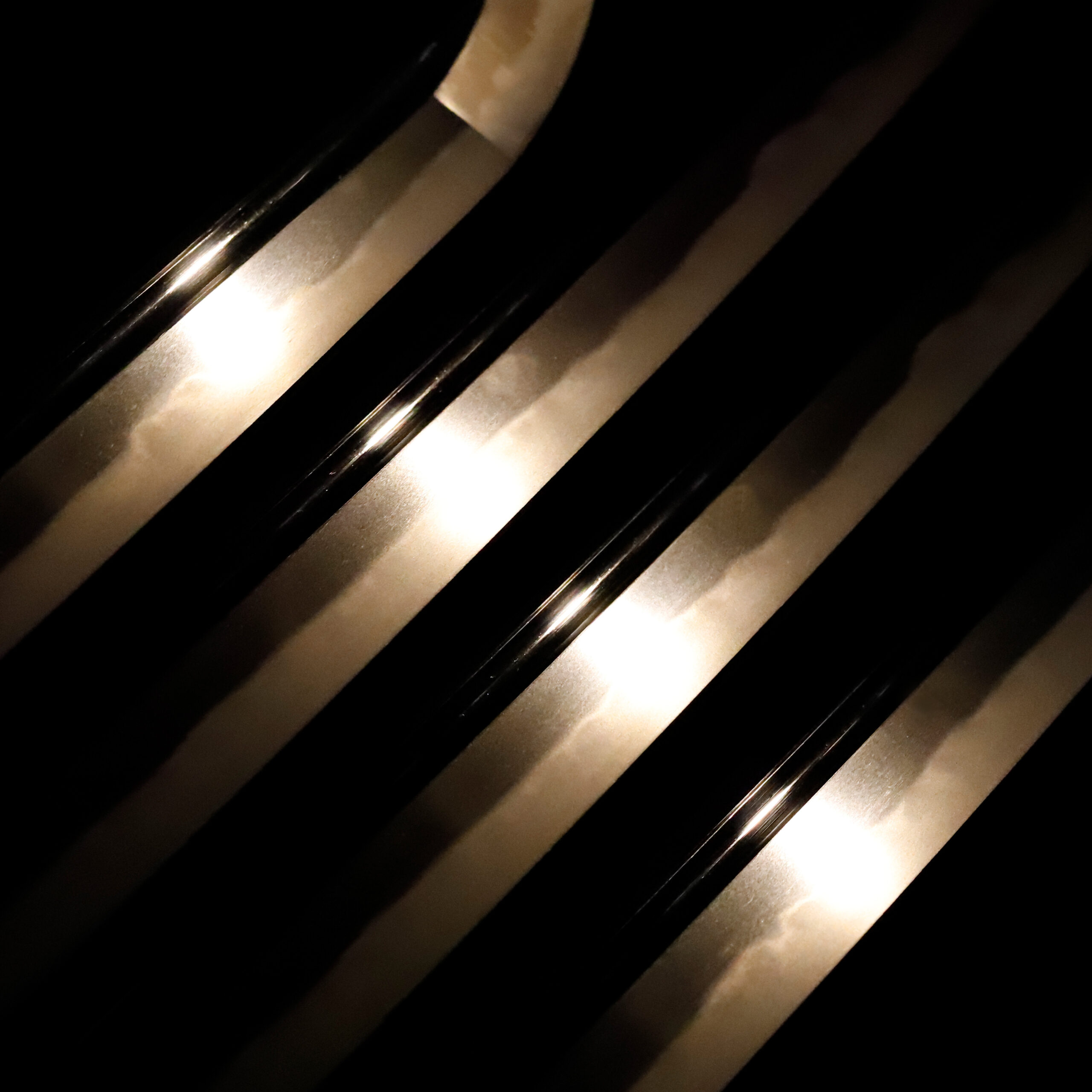
Nakago:Nakago is the tang of the Japanese sword.
Japanese swordsmiths left the black rust on the tang because it prevents red rust while the tang is in its handle. And the discoloration of the tang was created over time, and it is a great indicator for a Japanese sword specialist to estimate when the sword was forged.

Koshirae: Koshirae is the mounting of the Japanese sword. There are several parts that consist of Koshirae such as Saya(Scabbard), Tsuka(Handle), Tsuba(Handguard).
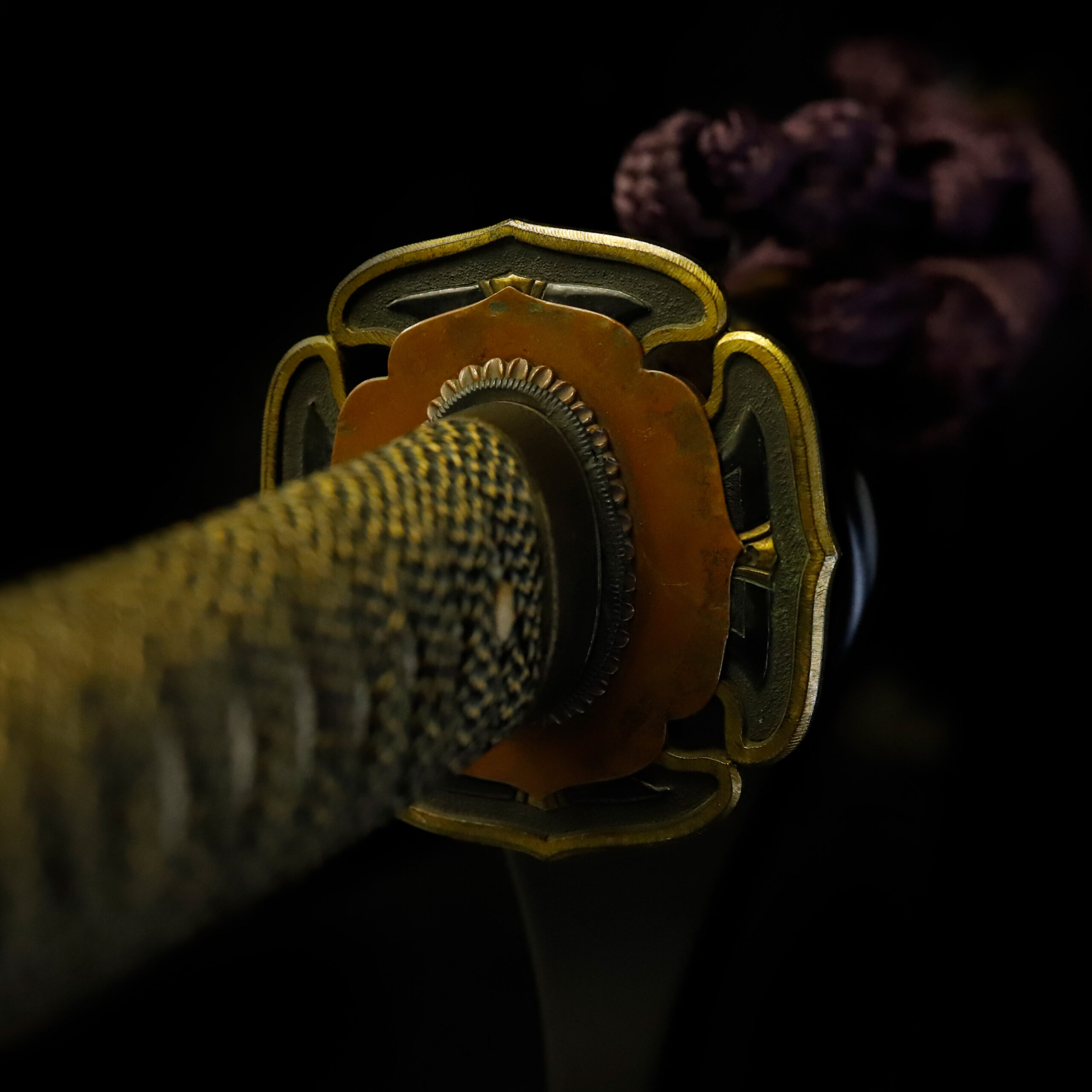
Fuchi-Kashira:A pair of matching sword fittings that cover the upper and bottom parts of its sword hilt.
The Kabutogane (冑金/兜金) is a metal fitting that is attached to the end of a handle. And a Sarute/Sarude (猿手) is attached to this Kabutogane. The user of a sword passed the Udenukio (腕貫緒, a cord wrapped around the wrist to prevent a sword from falling out of the hand, mainly used when riding a horse) through this ring. In addition, the Fuchi Kanamono (縁金物) is also a metal fitting attached to the handle, but on the opposite side of Kabutogane.
It seems all these black-colored metal parts of this handle have a stone-like surface. It is the same as other metal fittings such as Kuchi Kanamono (口金物, a metal fitting that is attached to the tip of the scabbard close to Tsuba), Seme Kanamono (責金物, a ring-shaped metal fitting placed in the middle of the scabbard to prevent the sheath from cracking), Ashi Kanamono (足金物, metal fittings attached to the positions where Sageo cord is wrapped), and Ishiduki Kanamono (石突金物, a metal fitting that is attached to the end of the scabbard).
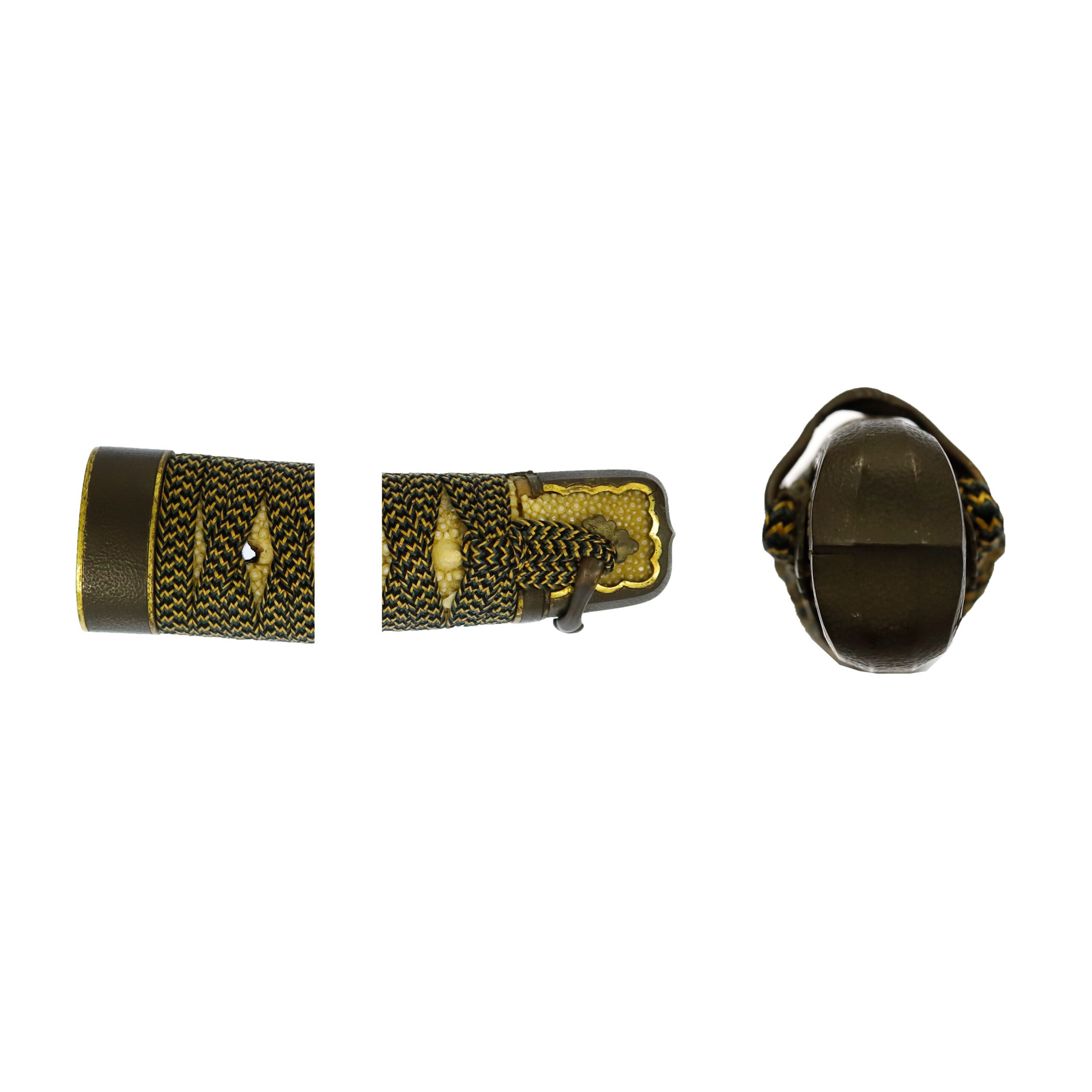
Tsuka and Menuki:Tsuka is the handle of the Japanese sword and Menuki is its decoration.
You could see the figure of the sword and a dragon wrapped around its blade part. This motif is called the Kurikara (倶利伽羅) pattern. It is the sword that Fudo Myo-O (不動明王, acalanātha) holds with his right hand. It is believed that this sword could cut off worldly desires: Sandoku (三毒). The Sandoku is the three fundamental earthly desires; Ton (貪, greed), Jin (瞋, anger, grudge), and Chi (癡, delusion, complaint). Fudo Myo-O is one of the objects of worship in Buddhism. According to a theory, it is the incarnation of Dainichi Nyorai (大日如来, Mahāvairocana, the principal image of esoteric Buddhism). Because of its sturdy appearance, it came to be worshiped as a god of war and is said to have been worshiped by many Samurai.
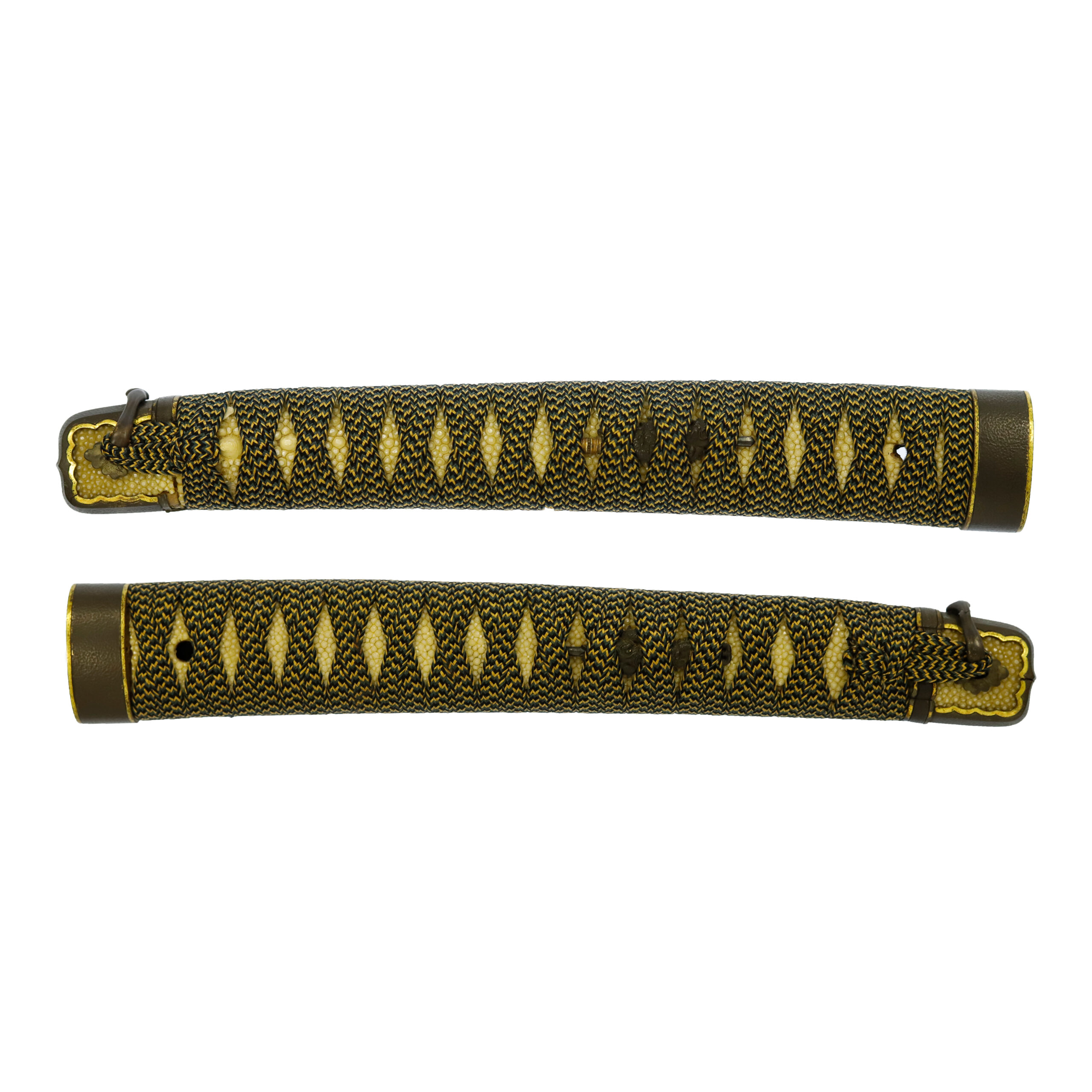
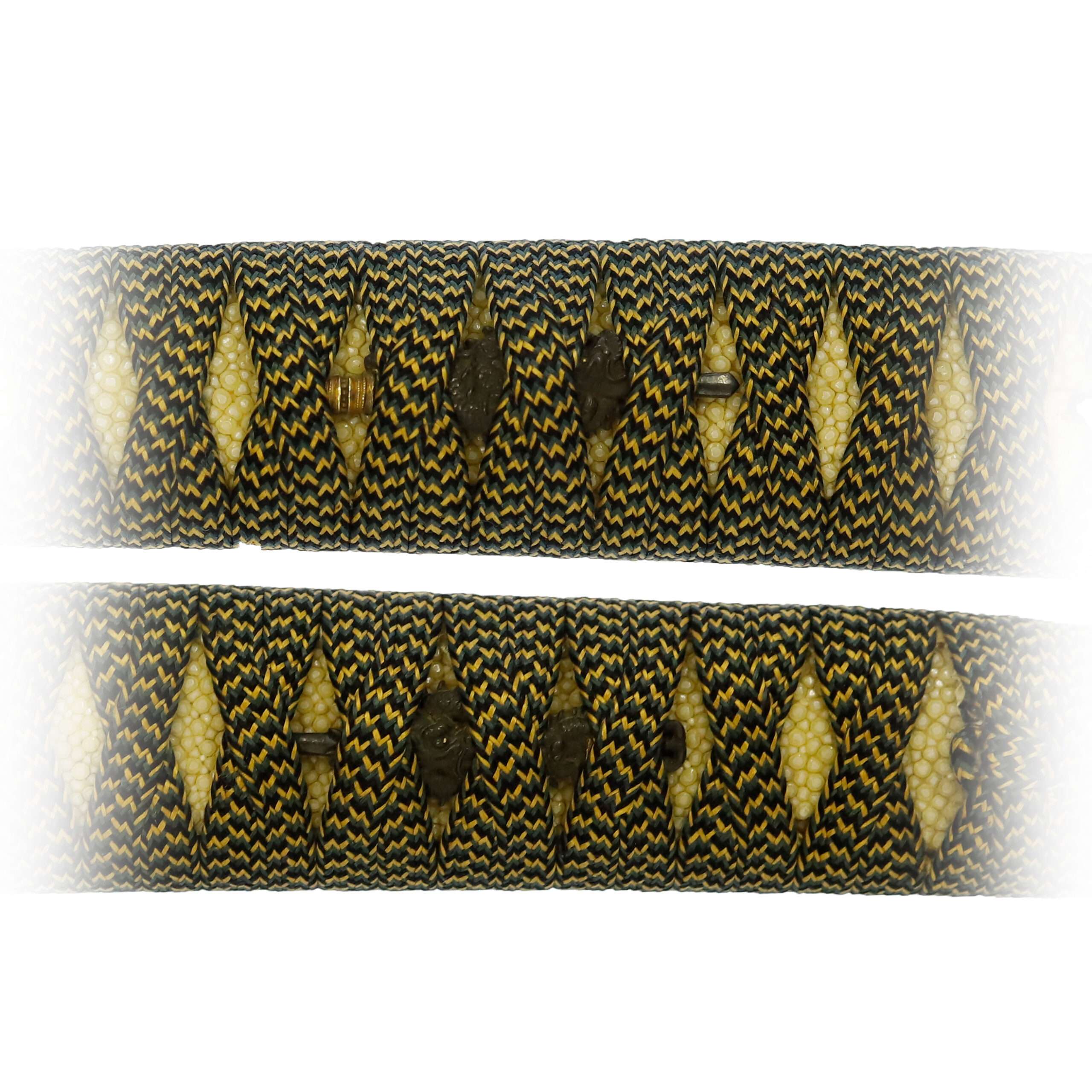
Tsuba and Habaki:Tsuba is the handguard for the Japanese Sword and Habaki is the equipment to make the blade not touch its scabbard inside. It prevents the blade from getting rusty and chipped.
This is a typical shape of the Tachi Goshirae Tsuba (太刀拵鐔). The difference between Tachi Tsuba (太刀鐔) and Katana Tsuba (刀鐔) is that the top and bottom positions of the Nakago hole (茎櫃, center hole) are reversed. The Tsuba of this Koshirae has Aoi (葵) Tsuba shape.
The Ju-Ji (十字, cross) pattern is designed with golden metal. According to the certificate, the Tasuki (襷, geometric pattern with intersecting diagonal lines) pattern is also designed on this Tsuba. However, now it is challenging to see because of aging.
If you focus on four corners and the tips of the golden cross mark, you will find a heart mark-shaped hole is engraved on each edge. It is called the Inome (猪の目) pattern. The Inome pattern has been used since ancient times. As its name implies, the boar’s eyes are the origin of this pattern. Some people believed the Inome design would work as an amulet to protect them from evil spirits or fire. Also, it is said it would bring good luck. On this Katana’s Koshirae, you could also find this Inome pattern on the scabbard.
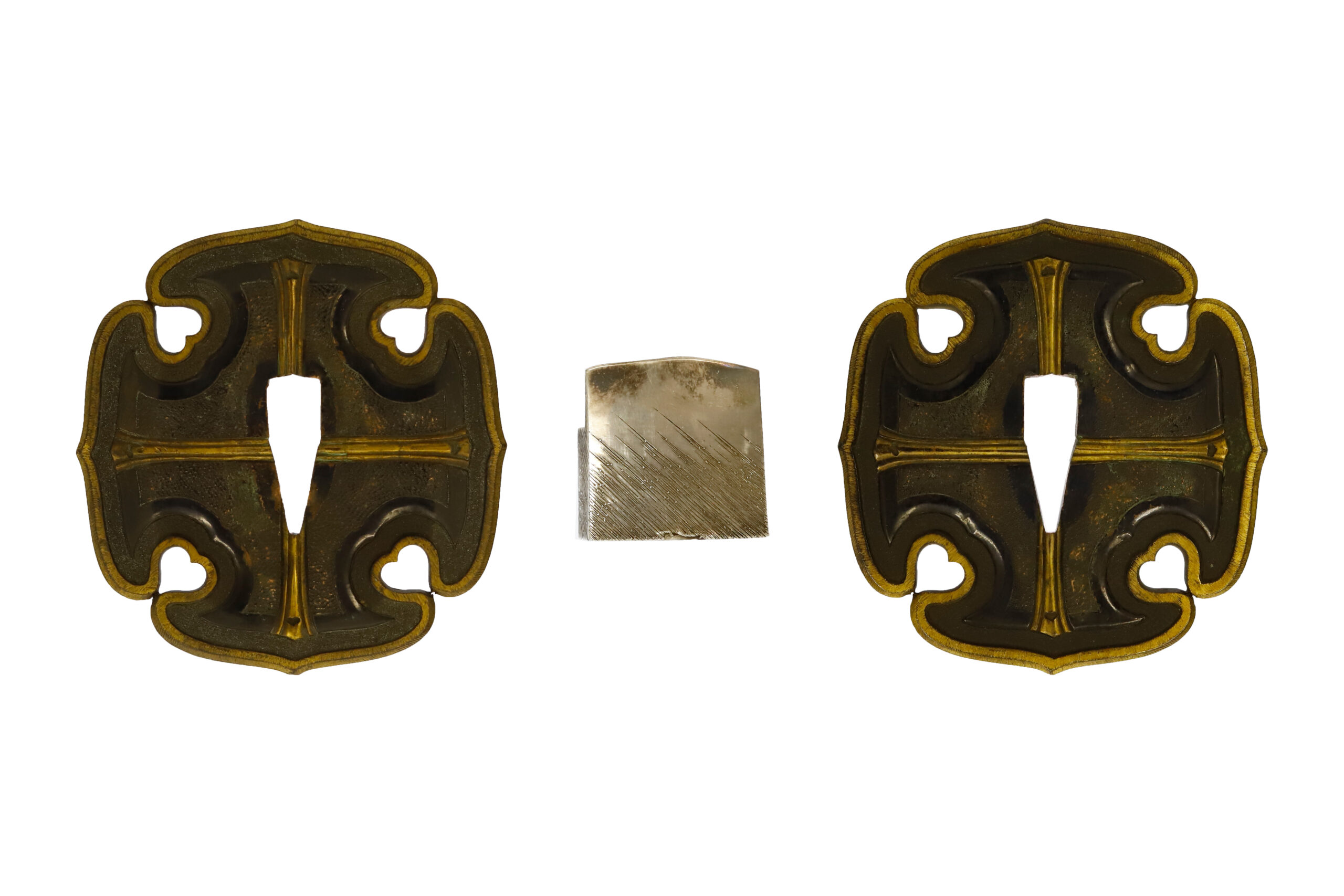
Saya: Saya is the scabbard for the Japanese sword.
If you focus on the middle and tip of this scabbard, you will find the Suhama (洲浜) patterns. The Suhama is an island-shaped sandbank that is formed on a coast. This design seems to be three circles arranged side by side and similar to the Japanese character’s shape: 品. We estimate that the Suhama patterns were designed on this scabbard as family crests. The Suhama pattern comes from Suhama-Dai (洲浜台), which was used in celebrations. It is said its auspiciousness is why Suhama patterns were incorporated into family crests.
You would also capture a Japanese letter on the tip of this scabbard. It is written as 扇, which means a fan. We believe it is a type of Moji (文字, character) pattern because the character’s shape is deformed to fit in a circle. Many of the family crests depict animals and plants. However, some arranged characters, as seen on this family crest.
*Please keep in mind that there are some areas where lacquer came off. If you like to see the detailed condition, please check other photos or contact us.
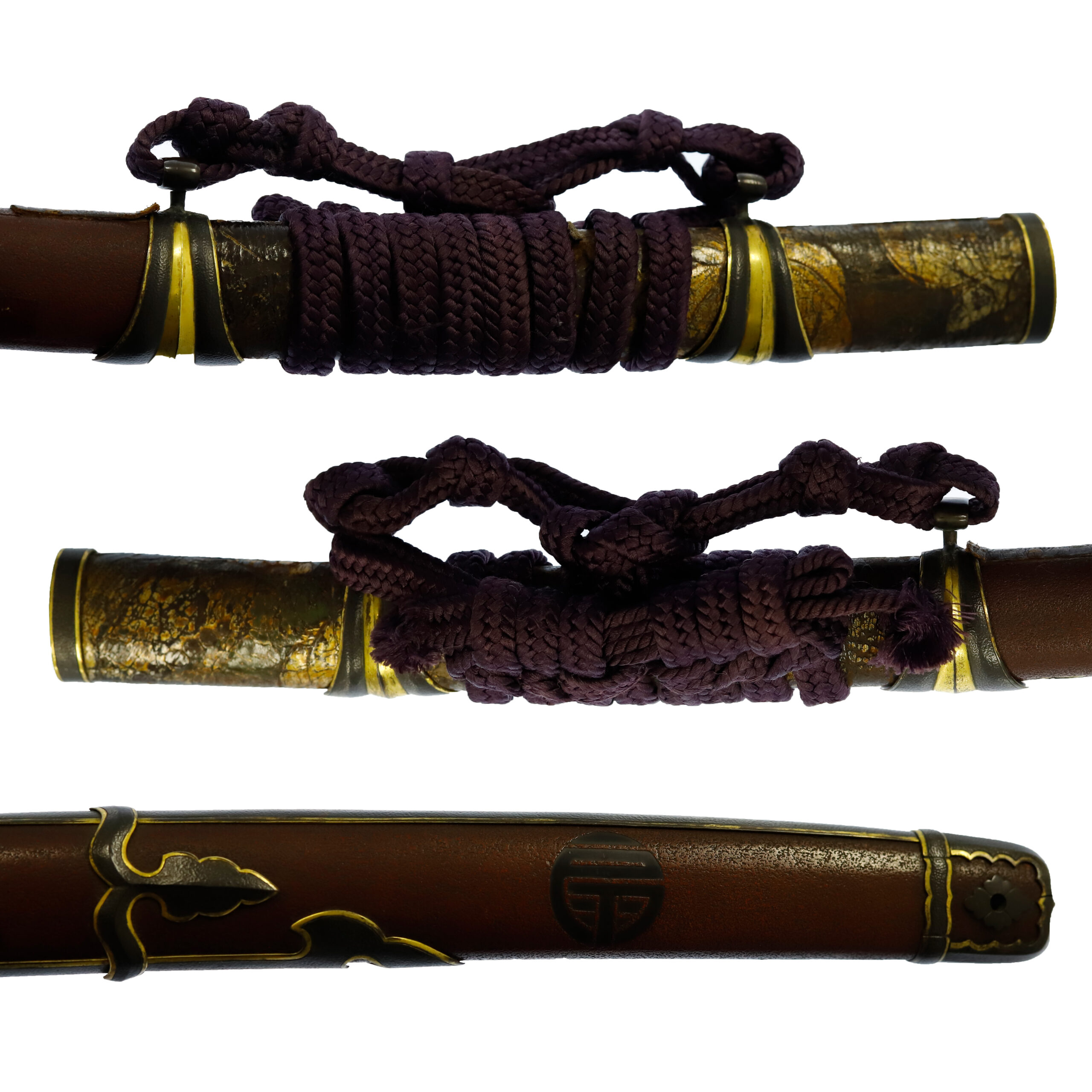
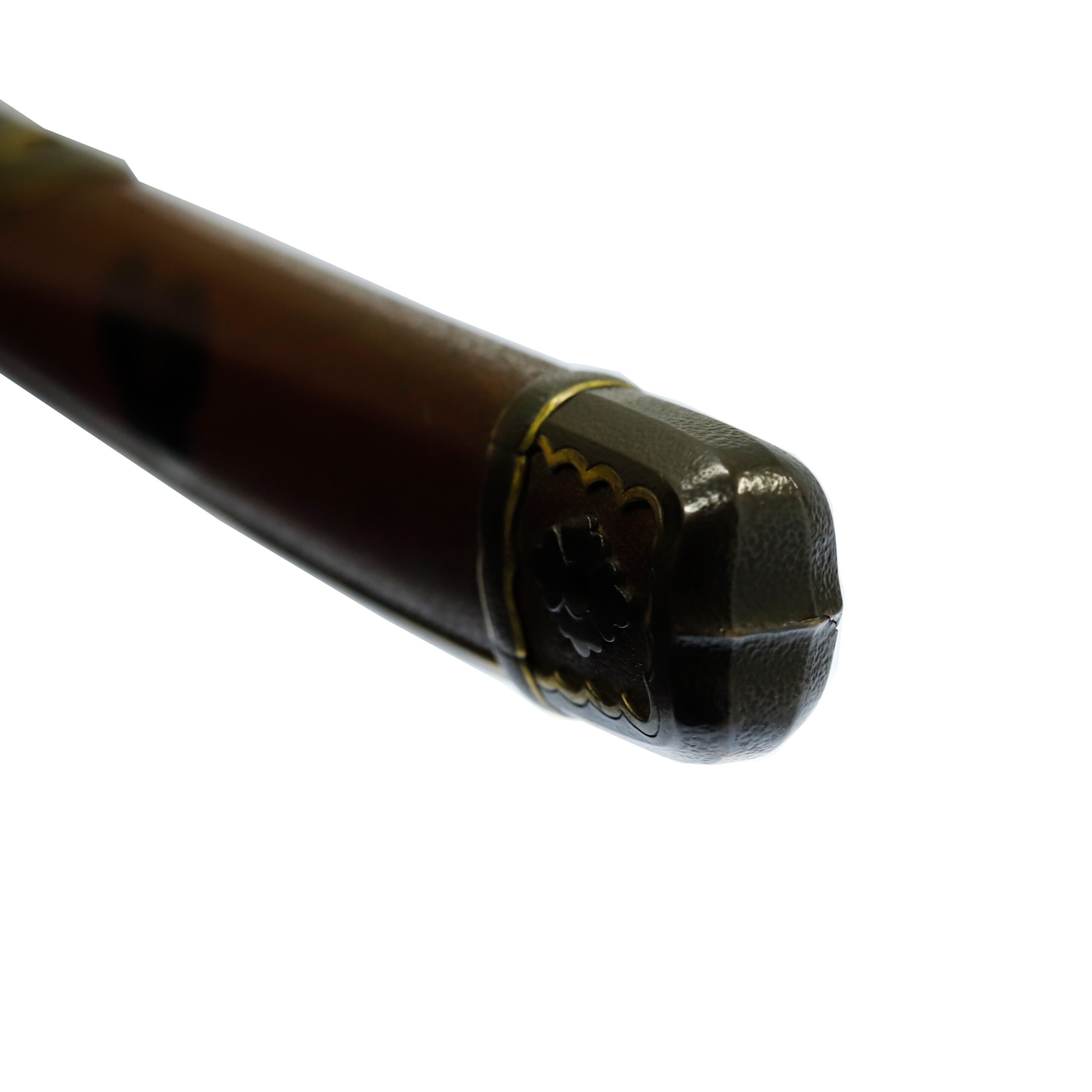
Authentication Paper:NBTHK TOKUBETSU Hozon Certificate for the blade (No. 1005602) and Koshirae (No.2003625)
NBTHK, also known as Nihon Bijutsu Touken Hozon Kyokai (the Society for the Preservation of the Japan Art Sword), is one of the oldest Japanese sword appraising organizations in modern-day Japan. They authenticated the blade on July 21st in the 28th year of Heisei (2016). Its Koshirae (sword mounting) was also authenticated in the same year. They appraised them as Tokubetsu Hozon Touken& Tosogu, the blade&sword mounting especially worth preserving for Japanese society. The purchaser will receive these original certificates as well. We can also translate what is written into English and make a PDF file for your record if you request.
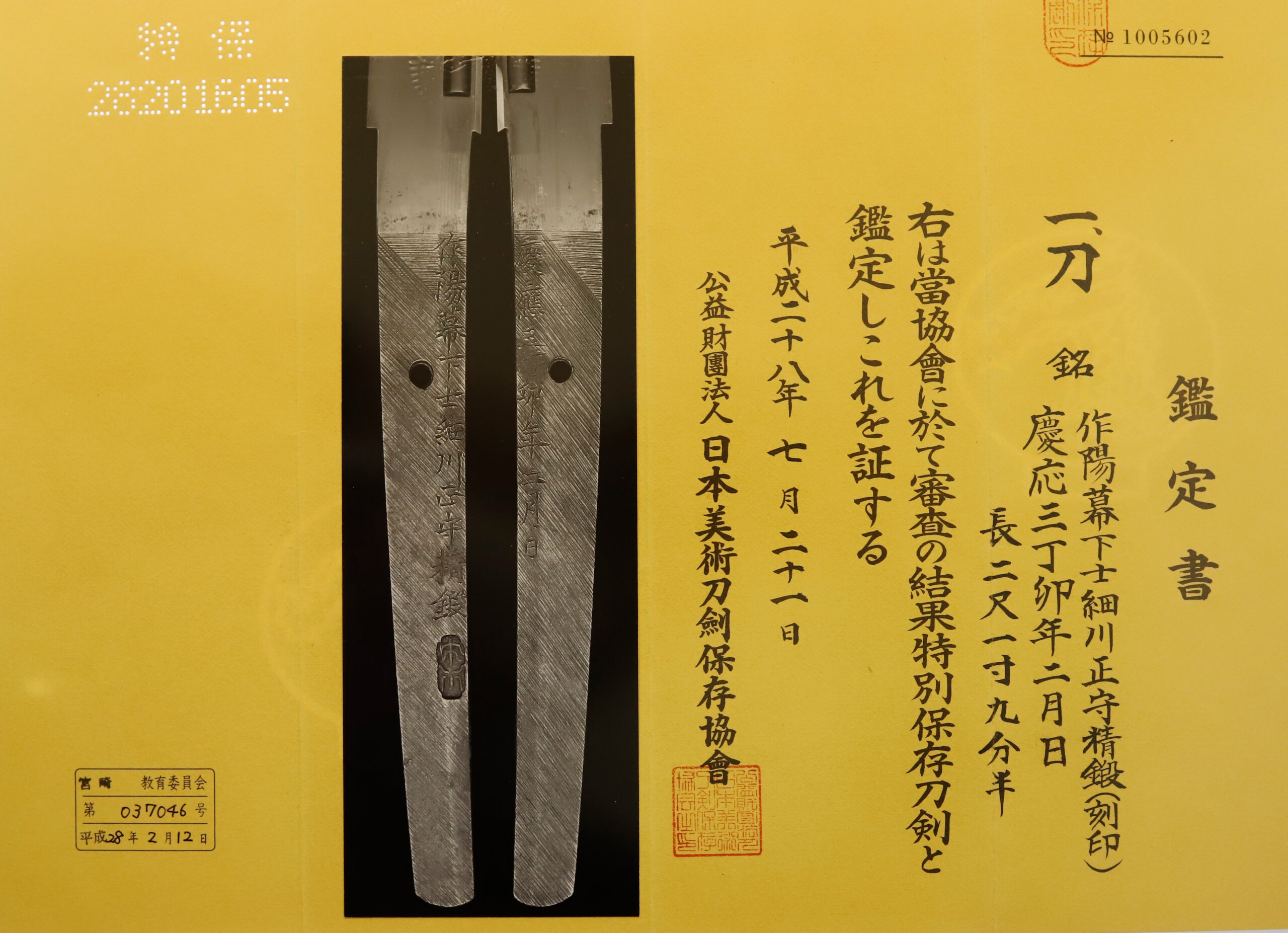

Registration Number : Miyazaki 037046
The Board of Education in Miyazaki prefecture issued a registration paper for this sword . It is called Jyu Token Rui Torokusho(銃刀剣類登録証). Bunkacho(The Agency for Cultural Affairs) acknowledges a Japanese sword with this paper as a work of art.
The sword needs to be traditionally hand-forged and made of Tamahagane carbon steel to be registered in the system. With this paper, its owner in Japan can legally own an authentic Japanese sword. Based on this registration number, we will apply for its export permit.
This paper will need to be returned to the board of education when the sword is being shipped abroad, but you can receive a copy of it. An English translation of this registration paper is available on request.

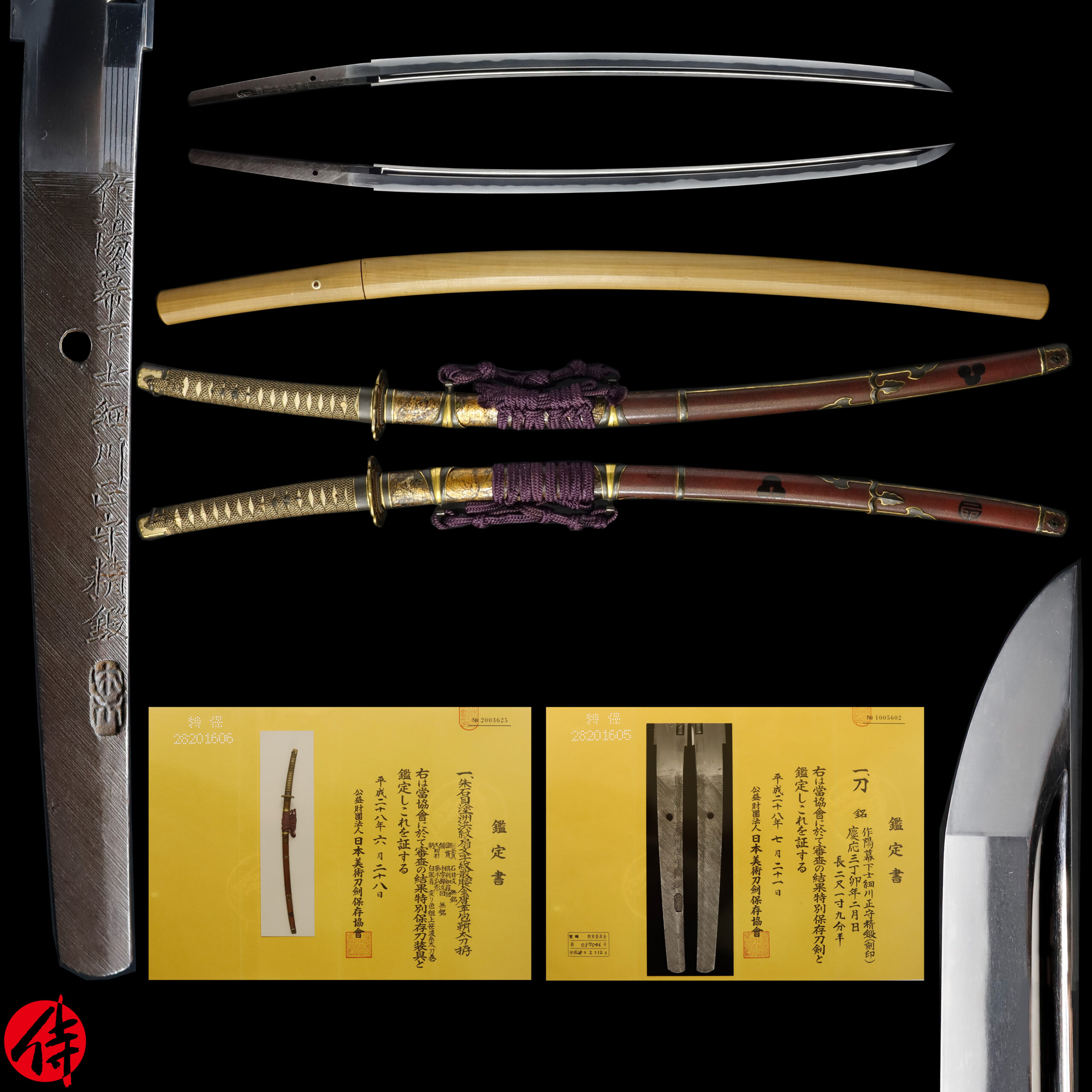
—————————————————————–
【About us】
Samurai Museum is located in Tokyo, Japan, exhibiting antique artifacts related to the Samurai history. Samurai Museum Shop is the place for those who are interested in Japanese culture and craftsmanship. We deal with antique Samurai swords/armor, traditional crafts made in Japan and so on.
【Japanese Sword& Export Process】
The Japanese swords we deal with are hand-forged edged swords made in Japan. It was made from the traditional carbon steel called TAMAHAGANE(玉鋼). Samurai Museum is familiar with the proper legal procedure for an antique/ authentic Japanese sword to be exported from Japan. We have sent more than 500 Japanese swords for the past three years (~2023) to amazing owners who appreciate its historical value.
Each Japanese sword is registered under the Agency for Cultural Affairs and the Board of Education in Japan. They issue a registration paper for each Japanese sword for its owner in Japan to legally possess it. The Japanese sword with its registration paper means it was traditionally hand-forged in Japan.
To legally export the sword from Japan to other countries, we will have to apply for its permit to the Agency for Cultural Affairs(Bunkacho) and return the original registration paper to the Board of Education. It normally takes around 2-4 weeks to receive this permit after submitting required documents. And we would like you to expect at least 1-1.5 months for your order to arrive at your given address after you ordered. For more detailed info, please click here.
It is allowed for residents in Japan to own authentic Japanese swords without a special license as long as they come with registration papers. Please feel free to contact us if you are a resident of Japan, whether temporarily or permanently. We will also assist you when you leave Japan and need to obtain the export permit.
【Payment Method】
We accept payment through Stripe (Credit card), PayPal, Apple Pay or ChromePay, all of which are secure payment methods. Also, you don’t need to make an account on Stripe for the checkout. If you prefer other payment method, please contact us. After confirming your payment, we will apply for an export permit. You may either pay in JPY, USD, AUD, CAD,EUR CHF or GBP. The price is set in Japanese Yen. Prices in other currencies are automatically calculated based on the latest exchange rate.

* If the amount is above 1 million JPY, Stripe or wire transfer will be the only options for payment.
【Shipping】
We have shipped authentic Japanese swords to the USA, UK, Canada, Mexico, Germany, France, Hong Kong and Australia. If you don’t live in these countries and like to order, please contact us first before making a purchase. We offer Free International Shipping as long as we can send antique Japanese swords by EMS.
We normally ship by EMS(Express Mail Service) provided by Japan Post. We will send you a tracking number for your order as soon as we hand it to the post office. We will put 100 % insurance on the shipping document without any extra charge. Based on the total amount, there might be a duty tax or other fee for you to pay, depending on the countries. We use package cushioning to protect the item and put it in a PVC pipe, which is one of the most secure packages because of its durability.
It will normally takes 5-14 days for the item to arrive at your given address after we dispatch it. Time of delivery is estimated as accurately as possible by the carrier but does not take into account any delays beyond our control such as by inclement weather, post office holiday seasons.
* If you live in Australia and like to purchase an authentic Japanese sword, please click here to know the detail.
*Please keep in mind that due to the spread of COVID-19, there might be delays in shipping. If you like to know the detail about shipping, please feel free to ask us.

【Review】
Here is one of the reviews we received from a customer who purchased an authentic Japanese sword from us. For more reviews, please click here.
“My experience overall with the whole process was wonderful. I had many questions about the history and process to purchase these treasures. All my questions were answered very timely and complete. The staff is very knowledgeable and very well versed if any questions do arise.”
【How to make sure the condition】
Please keep in mind that what you are going to purchase is an antique item. We uploaded high resolution photos for you to check its condition thoroughly. If you like to see more photos with different angles, please feel free to contact us. We will be happy to send them to you so that you can make informed decision. It is essential for us to know that you are happy with your choice of a sword. and we are prepared to use the best of our ability to serve you.
【How To Contact Us】
Please contact us through email, Facebook Messenger or Live Chat if you have any questions. You can find each icon on the right side of the website. Please click one of them to reach us. We will reply to you within 1-2 business days.
【The Art of Nihonto (Japanese Sword)】
Samurai’s history is a profound, eloquent legacy of ancient Japanese warriors in which millions of people worldwide are being fascinated. If you like to find out the art of Nihonto, please click here.
【A Guide to Japanese Sword Maintenance】
After acquiring an genuine Japanese sword, it is also important to know how to take good care of it. Here is the special video for you. Mr. Paul Martin, Japanese sword expert, shows you how to give proper maintenance to your sword. By mastering how to clean the Japanese sword, its aesthetic beauty will last forever.
When you purchase a Japanese sword from us, you can get a Free Japanese sword maintenance kit. It comes with four tools(Choji Oil, Uchiko Whetstone Powder, Peg remover, Oil Applicator). By watching the video instruction above , you can enjoy learning how to maintain your Japanese sword while appreciating it. If you have any difficulty assembling the sword or cleaning the blade, you can feel free to contact us.


MORE ANTIQUE JAPANESE SWORD FOR SALE
SWORDS WITHOUT CERTIFICATES FOR SALE
LEARN JAPANESE SWORD TERMINOLOGY
Thank you for reading all the information on the page. If you have any difficulty choosing the right Japanese sword for you, we will be more than happy to help you find the one that speaks to you the most. Please feel free to contact us.
